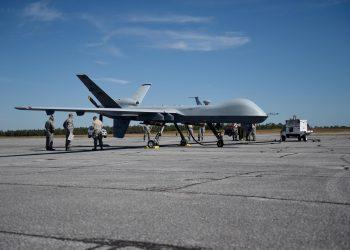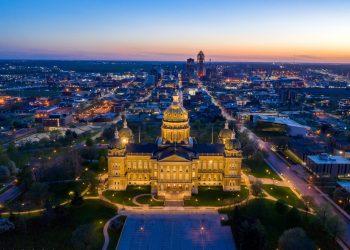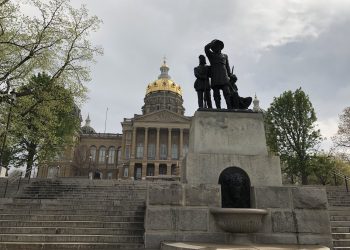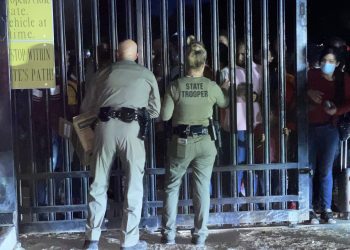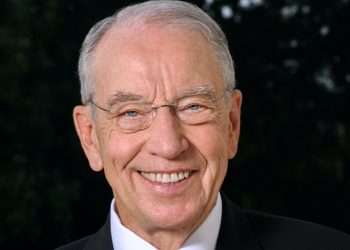DES MOINES, Iowa – Gov. Kim Reynolds’ addressed the COVID-19 vaccine shortage the state is experiencing and updated Iowans on the state’s vaccination plan during a press conference on Thursday morning at the Iowa PBS studios in Johnston.
It was the governor’s first press conference of the year.
“I know that many Iowans are eager to be vaccinated and simply want to know when it will be their turn,” Reynolds said.
“I am proud of the progress that we’re making. We’re doing a lot with relatively little vaccine. Iowa ranks 46th nationally in the amount of doses allocated to our state, near the very bottom of the list. And, in fact, we are only receiving 19,500 doses per week,” she added.
However, Reynolds pointed out that the state ranks 15th in administering the COVID-19 vaccine.
“As soon as our weekly vaccine allocation is received, it’s going out the door and into the arms of Iowans across the state,” she said.
Reynolds said Iowa has received, in total, over 160,000 1st doses of the vaccine. She added that more than 106,000 doses had gone primarily to Iowa’s healthcare workforce.
“As of yesterday, 82% of the total first doses that we’ve been allocated by the federal government has been used to protect those who have been providing care for Iowans since the beginning of the pandemic,” she said.
Reynolds announced that more than 22,000 healthcare workers in the state received their second dose and are completely vaccinated.
Getting long-term care facility residents and staff vaccinated is taking longer than expected.
“Unfortunately, like many other states, the vaccination program run by the federal government and our national pharmacy partners for residents and staff of the states nearly 450 long-term care facilities has been slower than anticipated,” Reynolds said.
“Nearly 116,000 doses, and that’s in addition to the 19,500 that the state receives, has been allocated to this program. And I will say that significant progress has been made in the last two weeks. We’ve been assured by the providers that first doses will be completed statewide by the end of the month, and we continue to monitor that daily,” she stated.
Reynolds said it is time for the state to move to phase 1B and make the vaccine available to more Iowans, with phase one of the state’s vaccination plan “well underway.”
“I want to be very clear. This does not mean that we can open vaccination up to all Iowans or even that vaccine will be immediately available to all of the groups that have been prioritized in phase 1B. The national vaccine supply remains limited,” she warned.
Reynolds also said despite some reports, states are not able to order additional doses.
“Our allocation is determined and distributed at the federal level, and we rely on the numbers that they provide to plan our response and our approach. We anticipate that our weekly allocation could begin to increase starting the week of February 1,” she said.
Reynolds noted that the Trump Administration projected Iowa’s allocation could increase to 39,000 by the week of February 8 and could continue to grow by 10,000 doses each week throughout February.
She added that those projections could change with the Biden Administration introducing their vaccination plans.
“We are working with the administration to see what that looks like and how we can plan accordingly. But allocations are always subject to change in demand for the vaccine and demand for the vaccine will be much greater than the supply for some time,” Reynolds stated.
She noted IDAC’s phase 1B recommendations initially prioritized Iowans age 75 and older, first responders, teachers, and essential frontline workers.
Reynolds noted the national push to vaccinate older Americans who are most at risk for serious illness and hospitalization, so they updated the phase 1B plan to further expand older Iowans’ eligibility.
She announced Iowans 65 years-of-age or older would be eligible for the vaccine on February 1 that accounts for more than 500,000 Iowans.
She said that early February tier one prioritizes law enforcement, first responders, pre-K-12 teachers and staff, early childhood educators, and childcare workers could begin vaccination at local pharmacies or clinics in early February. Those groups account for approximately 130,000 Iowans.
Tier two included front frontline essential workers and individuals with disabilities living in a home setting, approximately 600,000 Iowans. Tier three includes staff and individuals in congregate settings and also government officials, about 13,000 people. Tier four includes 1500 inspectors responsible for health, life, and safety. Tier five consists of approximately 13,000 staff and incarcerated individuals in correctional facilities.
“With our current allocation from the federal government of 39,000 per week beginning February 9, this process is just going to take time. Each subsequent tier will be phased in as soon as possible according to the vaccines’ availability and where they’re at throughout the state,” Reynolds said.
“So you can see that this is no small undertaking, and I cannot emphasize enough that I once will need to be patient. Vaccines are coming. And you know, there’s good news on the horizon, but it’s just going to take some time. Once we complete 1B, we will have vaccinated half of Iowa’s eligible population. But it will again require our weekly allocations to continue at their projected volumes, and any changes to allocation will impact the pace of vaccination and our ability to move to the next tier,” she added.
Reynolds explained that she is optimistic about the state’s ability to expand vaccine administration as additional vaccines enter the market.
Watch Reynolds’ discuss the vaccine shortage and Iowa’s updated vaccination plan above. Listen to the full press conference below:




